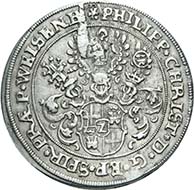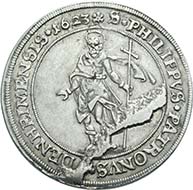In 1610, Philipp Christoph Freiherr von Soetern was elected Bishop of Speyer. Therewith, a man became ruler over one of the most important German bishoprics who had been baptized as a Protestant in the first place. After all, his father had adhered to that confession. The family on his mother’s side, however, was Catholic to the last degree. Namely his mother’s brother had made a career as canon of Trier and sent the skilled young man – of course after he had ‘converted’ to the Catholic faith – to the Jesuit College where all future Catholic rulers were educated. And Philipp von Soetern did make a career. For him, the office of bishop in Speyer was only a waypoint. In 1623, he was elected Bishop of the Archbishopric Trier in addition.
That, however, put Philipp von Soetern in a politically difficult situation. His territories were located between the German and the French Empires which were fighting on different sides during the Thirty Years’ War. Plus, the Calvinistic Rhenish Palatinate was in close proximity. Hence, the moment he was elected Bishop of Speyer it was quite clear that he would be forced to defend his bishopric. He decided in 1615 to enlarge his residential city of Udenheim into a modern fortress with redoubts, bulwarks and trenches. That took some time. On May 1, 1623, the fortress was inaugurated.
Bishopric of Speyer. Philipp Christoph Freiherr von Soetern, 1610-1652. Reichsthaler 1623 on the fortress of Udenheim. From Künker auction188 (2011), 1248. Estimate: 15,000 Euros.
This is the context of a coin of utmost rarity, which will be auctioned off at Künker’s on June 20, 2011. The obverse displays the bishop’s coat of arms and states titles and names. The coat of arms consists of the two crests of the principalities of Philipp von Soetern, the cross of Trier, the crowned castle of the prince’s provostry of Weißenburg. The ramshorn hook in the shape of a Z on the heart-shaped shield is the family crest of the bishop.
The reverse shows Saint Philipp, patron saint of the bishop and – as stated in the legend – likewise patron of Udenheim. The patron was to give the new fortress his name: shortly after the coin was minted, it was renamed into Philippsburg.
One of many sieges of Philippsburg – in fact the most famous one of 1676. Source: Wikipedia.
The building of the fortress had cost the bishop a pretty penny. And if that was not enough: his new residence, Philippsburg Castle in Ehrenbreitstein near Koblenz, cost an arm and a leg, too. The secular ruler responded with a rigid tax policy which loaded all expenses of his building projects onto the citizens. It comes as no surprise that the latter were not at all happy with that. In fact, due to the taxes the bishop became that unpopular that the chapter, in cooperation with the citizens of Trier, tried to get rid of him.
For decades, the proximity to France had made it impossible for any bishop of Trier to come to terms with the neighbors. Now, however, France’s First Minister, Richelieu, supported the Protestant Swedish. The citizens of Trier had only to apply to the emperor, and he in fact did conquer Trier, with troops of the House of Habsburg.
Philipp Christoph von Soetern, engraving about 1650. Source: Wikipedia.
In doing so, the emperor ultimately pushed Philipp von Soetern onto the French side. In 1631, he left the fortresses of Ehrenbreitstein and Philippsburg to the French who, in turn, re-conquered Trier for him. When he promoted the election of Richelieu to become his co-adjutor bishop – which would have granted the French influence in the voting of the Bishopric of Trier at the next emperor’s election – he overstepped the mark. The emperor drove out the French and re-took Trier as well as the fortress of Philippsburg. The stubborn bishop was imprisoned in Linz. He was to remain the emperor’s captive for about ten years.
When he was released, Philippsburg was already in French hands again – where it remained after the Peace of Westphalia. The fortress was to become an apple of discord for endless wars to come between France and the German Empire. The tragic fate of Philippsburg only came to an end when its fortifications were razed by command of Napoleon at the beginning of the 19th century.









